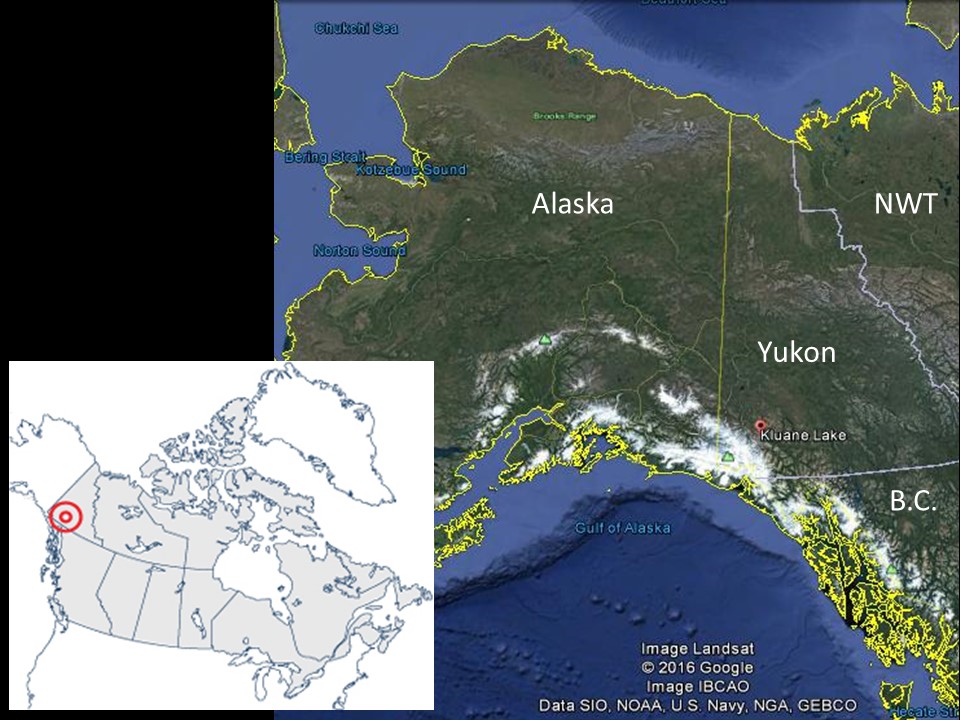Metadata
|
 |
Kluane Lake Research Station (KLRS)
Primary CryoNet Station Information
Other Networks to Which This CryoNet Station Belongs
- Canadian Network of Northern Research Operators (CNNRO)
- International Network for for Terrestrial Research and Monitoring in the Arctic (INTERACT)
- University of Calgary network of field stations
Measurement Methods Used
- WMO Technical Regulations
- CIMO
Other relevant measurement method documents:
Technical Regulations (WMO-No. 49), Volume I: General Meteorological Standards and Recommended Practices
WMO Instruments and Observing Methods, Report 102, CIMO Survey on Methods and Instruments for Solid Precipitation Measurement at Automatic Weather Stations
Data Information
- Are the data quality controlled? yes
- How are the data accessible? FTP, HTTP (web)
- Data availability (may depend on the variable measured): in near real-time, delayed less than one month
Publications
Additional Information Documents
Measurements
The measurements made at Kluane Lake Research Station (KLRS) are listed in the following tables. (Note: If End Year is blank, measurements are ongoing.)
Cryosphere Measurements
| Atmosphere Measurements
|
Measurement Notes and Other Measurements
| Category | Description or List |
|---|---|
| Snow | Fragmented = monthly, to be initiated in Fall 2016. Snow profiles will be snowpits sampled at 5 cm for density (100 cc box cutter), with temperature and grain size documented in the stratigraphy. Snowpack chemistry: just water isotopes for now (D/H, d17O, d18O) Continuous snow depth is from an SR50 UDG, and albedo is from a four-component radiometer. |
| Freshwater ice | Fragmented = monthly, to be initiated in Fall 2016. Initial snow/ice thickness and albedo measurements will be done locally, at KLRS, but we have plans to expand to the neighbouring communities on Kluane Lake, and we will also benefit from adding a remote sensing component for the lake ice cover and regional snow cover extent. This will be part of the evolution from the primary station at KLRS to a broader CryoNet Site, with welcome input and feedback from EC, WMO, and GCW as we shape this broader proposal. |
| Permafrost | Ground temperature, heat flux, and active layer depth measurements are to be initiated at the KLRS site, likely in conjunction with Yukon College. Other permafrost measurements may follow, but a plan is not yet in place and we propose to add this component in 2017. |
| Glacier | Winter and annual mass balance to be initiated at a site in the St. Elias, but not yet in place. Likely in conjunction with G.E. Flowers, SFU. Several glaciers in the region have been studies for ~40 years for ice velocity, area, thickness, elevation change, and ice dynamics; sporadic. |
| Hydrology | Some work is being done on the water balance of Klaune Lake (Slims River input flux, lake volume, lake height variations). This is KLRS-based research that we could tap into as part of the integrated CryoNet Site, as appropriate. |




The extreme elevation difference between Kluane Lake and the crest of the St. Elias Mountains establishes a strong gradient in environmental attributes and results in a remarkable diversity of research opportunities within a small geographical area. This diversity is reflected in the unique scientific legacy of KLRS, which supports research projects spanning the disciplines of glaciology, geomorphology, geology, biology, botany, zoology, hydrology, limnology, climatology, high-altitude physiology, anthropology, and archaeology.
KLRS is a member of the Canadian Network of Northern Research Operators (CNNRO) and the International Network for for Terrestrial Research and Monitoring in the Arctic (INTERACT). Both networks work to build capacity for terrestrial research, to improve collaboration and coordination of efforts, enable access to partner stations, and implement best practices for station management, use and station-based research and monitoring.
Researchers working out of KLRS have made campaign-based meteorological, permafrost, snowpack, and glaciological measurements over many decades, working at different locations in the region, but these data have not been co-ordinated, and they are not necessarily useful to the GCW program as they are intermittent, of unclear quality, and metadata is poorly documented. There is nevertheless a good backbone of knowledge on the regional climate and cryosphere, and its changes, and this can be useful contextually as we move forward to a Kluane CryoNet Site, with the Kluane Lake station serving as the primary/base station. This researcher base will be tapped for assistance in an Arctic-Institute co-ordinated effort to collect systematic regional cryosphere-climate data moving forward. Local to international researchers will benefit from the associated data rescue and the centralized data management and online availability that AINA will contribute to this.